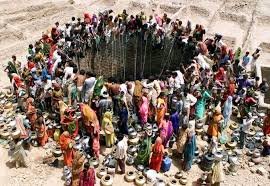The 2024 Global Multidimensional Poverty Index shows that poverty is not just about income.
Poverty is more than the lack of money. It is about being deprived of basic needs. The 2024 Global Multidimensional Poverty Index (MPI) provides insight into what poor people face daily. This report reveals the different deprivations that more than 1.1 billion people endure across the world. Over half of these individuals are children. The most common deprivations include inadequate housing, lack of sanitation, poor nutrition, lack of cooking fuel, and limited access to schooling.
Inadequate Sanitation
Among the world’s poor, inadequate sanitation is a major challenge. About 828 million people lack adequate sanitation facilities. This means they do not have access to clean, safe toilets or waste management systems. Poor sanitation leads to severe health issues. It increases the spread of diseases. In places without proper sanitation, people face the constant risk of illness. Children are the most affected. They are vulnerable to infections and health complications.
Lack of Adequate Housing
Housing is a basic need. But for many, it is a luxury. Around 886 million poor people live in inadequate housing. These homes often do not provide sufficient protection from weather elements. The structures are made of weak materials. In areas prone to natural disasters, this makes poor families vulnerable. Unsafe housing conditions also affect mental well-being. People cannot feel secure when their homes are at risk of collapsing.
Lack of Cooking Fuel
Cooking fuel is essential. It allows families to prepare food. However, 998 million poor people do not have access to clean cooking fuel. Instead, they rely on solid fuels like firewood or charcoal. These fuels are harmful. They produce toxic smoke. When people inhale this smoke, it causes respiratory problems. Women and children are particularly at risk since they spend more time near cooking stoves.
Nutrition Deprivation
Well over half of the world’s poor are deprived of nutrition. Around 637 million people live in households where one or more members are undernourished. Inadequate nutrition is a serious concern in South Asia and Sub-Saharan Africa. In South Asia alone, 272 million poor people face nutritional deprivation. Poor nutrition has long-term impacts. It affects children’s physical growth and brain development. Malnutrition limits people’s ability to work and learn.
Lack of Electricity
Access to electricity is essential in today’s world. Yet, around 579 million poor people live without it. Lack of electricity means no light to study at night. It means no way to power a fan during extreme heat. Electricity provides comfort and opportunity. Without it, families remain in the dark—literally and figuratively. In war-affected countries, 26.9 percent of poor people lack access to electricity, compared to 5.6 percent in countries not affected by conflict.
Limited Education
Education is a powerful tool. It can break the cycle of poverty. However, over half of the poor live in households where no member has completed six years of schooling. This translates to about 590 million people. Education provides skills needed for better job opportunities. Without education, people remain trapped in low-paying, unstable jobs. Additionally, 482 million poor people live in households where one or more children are out of school. In conflict-affected countries, the proportion of poor people with out-of-school children is much higher.
Inadequate Drinking Water
Access to clean drinking water is another major deprivation. Nearly half of the poor population (513 million people) lack an improved source of drinking water. Clean water is essential for health. Without it, people suffer from waterborne diseases. Collecting water is often the responsibility of women and children. They spend hours walking long distances. This time could be spent in school or earning a living. Lack of access to clean water limits their opportunities and overall quality of life.
Children Face the Most Severe Deprivations
Children make up more than half of the 1.1 billion poor people. The report highlights that 27.9 percent of children live in poverty, compared to 13.5 percent of adults. Children are more vulnerable to all forms of deprivation. They need proper nutrition, healthcare, and education. Without these, they suffer long-term consequences. In conflict-affected countries, the situation is even worse. The number of children out of school or undernourished is significantly higher.
Poverty in Conflict-Affected Areas
Conflict makes poverty worse. In countries affected by war, the incidence of poverty is 34.8 percent. This is much higher compared to 10.9 percent in non-conflict countries. Conflict destroys infrastructure. It disrupts access to basic services like water, electricity, and healthcare. In Afghanistan, for example, the incidence of poverty increased from 2015 to 2023. Nearly two-thirds of Afghans are now poor. Conflict has made it difficult for families to meet their basic needs.
Slow Progress in Reducing Poverty
Progress in reducing poverty is slowest in areas affected by conflict. In these places, poverty reduction is often stagnant or reversed. Poor people in conflict zones experience multiple deprivations at once. The destruction of infrastructure and services makes it hard for them to improve their situation. The cycle of poverty continues for generations.
Key Facts on Deprivations Faced by the Poor
| Deprivation Type | Number of Affected People (in millions) |
|---|---|
| Inadequate Sanitation | 828 |
| Inadequate Housing | 886 |
| Lack of Cooking Fuel | 998 |
| Nutrition Deprivation | 637 |
| Lack of Electricity | 579 |
| Limited Education | 590 |
| Lack of Improved Drinking Water | 513 |
| Children Out of School | 482 |
You Learn
The 2024 Global Multidimensional Poverty Index shows that poverty is not just about income. It is about the deprivations that people face every day. Over 1.1 billion people experience multiple challenges, from lack of clean water to inadequate housing. The majority of these people are children. Addressing these deprivations requires targeted interventions. It requires global cooperation and focus on the most vulnerable populations. Only then can we make significant progress towards eradicating poverty and achieving the Sustainable Development Goals.





